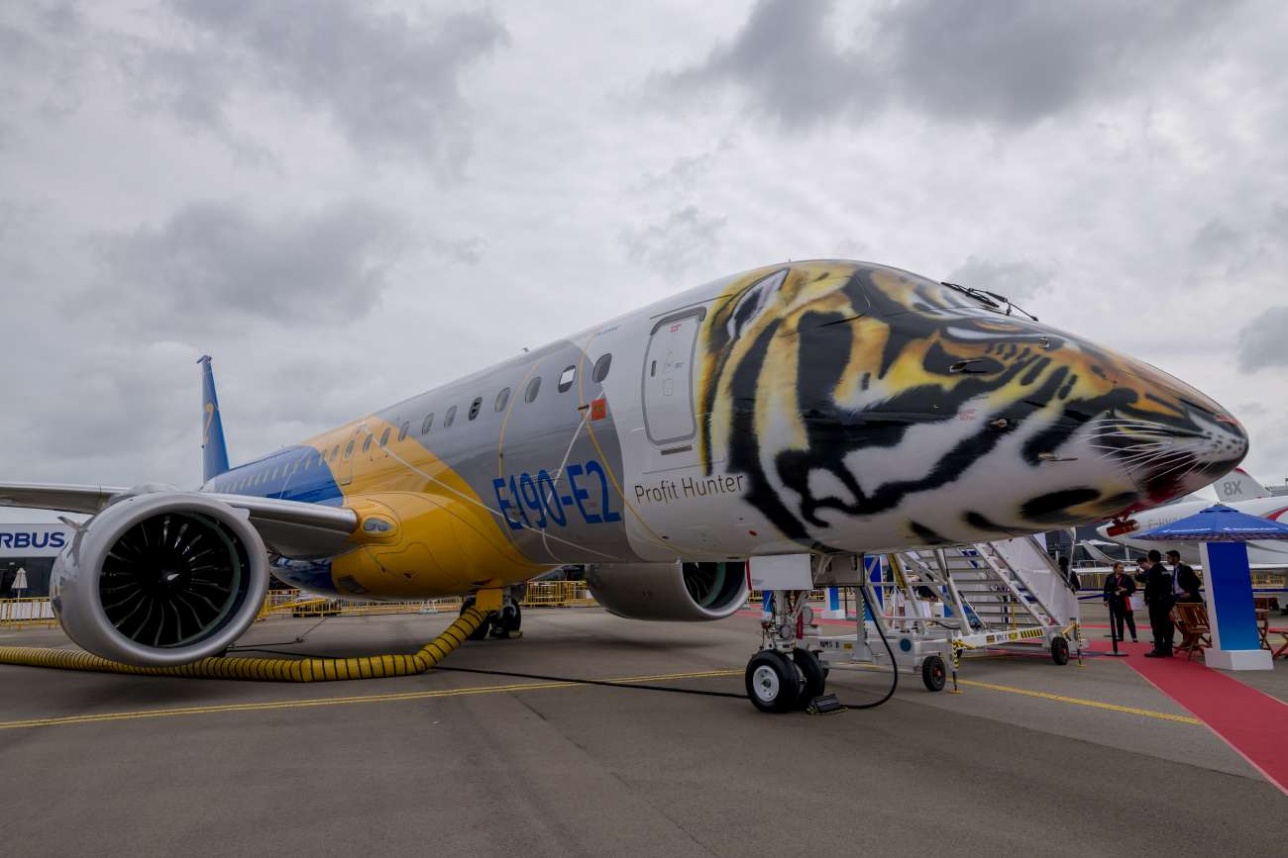This year’s Singapore Airshow, billed as “Asia’s largest aerospace and defense event,” featured the latest technologies and equipment by global aerospace companies, including Embraer’s E190-E2 jets, considered a new-generation passenger aircraft manufactured by the Brazilian aerospace conglomerate.
Shown for the very first time in Singapore on February 11, the E190-E2 is expected to contribute to worldwide upgrades to commercial airline fleets, and the Caspian region’s Kazakhstan is no exception.
“Air Astana will be one of the first airlines [in Kazakhstan] to operate this type of aircraft,” said Peter Foster, the Chief Executive Officer and President of Air Astana, the flag carrier of Kazakhstan, according to Informburo.kz.
The airline will modernize its fleet with five Embraer E190-E2 jets, following an agreement signed in 2017 between Air Astana and the world’s largest independent aircraft leasing company, AerCap, which is headquartered in the Netherlands. Air Astana expects to buy a total of 16 E190-E2’s.
The first batch is expected to arrive later this year, when the airplanes will be used to operate domestic flights inside Kazakhstan and flights to other Caspian or Central Asian cities, such as Baku, Bishkek, Tashkent, Dushanbe, as well as cities across Russia.
“At the moment we have 11 first-generation E-190 jets in our fleet, and we will gradually replace them once the new jets will arrive. We plan to update the fleet in a period of two years,” Foster said.
The Embraer E190-E2 aircraft is a narrow-body, medium-range, twin-engine passenger jet designed for medium-haul routes with a length up to 3,704 km (2,302 mi). Compared to its predecessor, the E-190, the latest version of the aircraft delivers double-digit percentage reductions in fuel burn and maintenance costs. The specialized technology used in the engines allows pilots to access real-time data, which, in turn, helps to fly the aircraft in the most cost-effective way.
Meanwhile, after the airshow in Singapore wrapped up, the brand new E190-E2 made a short stop at the Almaty International Airport, where it was showed off to Kazakhstani aviation bloggers and media representatives.
Branded by its Brazilian marketers as a ‘profit hunter’, the new jet looks unusual in its factory design – the nose of the aircraft displays a face of a tiger. This is not the first time Embraer has used images of animals in the design of commercial aircraft, however. Last year’s Le Bourget Airshow showcased Embraer E195-E2, with a head of an eagle on its nose.

“We call the E-2 a profit hunter, as the aircraft was significantly upgraded, while its economic efficiency was improved,” said Arian Mayer, Vice President at the Embraer Commercial Aviation in Europe and the Middle East.
“We realized that with the E-2 family of airliners, the cost of the flight will be much lower, and the cost of a seat will be very competitive compared to the Boeing-737 and A320.”
Air Astana’s fleet currently consists of 31 planes, including Boeing 767-300ER, Boeing 757-200, Airbus A320 and A320neo, as well as Embraer 190. Last year Astana Air ordered three new Boeing 787-8 jets.
While carrying about 4.2 million passengers in 2017, Kazakhstan’s national flag carrier recorded a growth in passenger traffic by 12 percent and revenue by 22 percent, after a fall in 2015 and 2016. At the same time, the company launched new flights to Delhi and Kiev, as well as increased flights to London, Beijing, Seoul, Moscow, St. Petersburg, Tbilisi, Istanbul, Dubai, and others.
“Our comparatively low costs allowed us to successfully develop this segment, being competitive in key foreign markets such as Russia, China, India, and the EU, as well as in smaller fast-growing markets such as Ukraine, Georgia, and Uzbekistan,” Foster said.







 President Aliyev emphasized the critical role of the North-South Transport Corridor in fostering transport cooperation between Azerbaijan and Russi...
President Aliyev emphasized the critical role of the North-South Transport Corridor in fostering transport cooperation between Azerbaijan and Russi...
 Armenian sappers commenced on Monday mine-clearance operations in the territories adjacent to the Saint Mary Church in village of Voskepar (Armenia...
Armenian sappers commenced on Monday mine-clearance operations in the territories adjacent to the Saint Mary Church in village of Voskepar (Armenia...
 The Mine Action Agency of Azerbaijan (ANAMA) reported on Thursday the discovery of a significant amount of explosives in the Khojavand district of ...
The Mine Action Agency of Azerbaijan (ANAMA) reported on Thursday the discovery of a significant amount of explosives in the Khojavand district of ...
 Russian Foreign Minister Sergei Lavrov has reasserted that Moscow has no intentions to stop the fighting in Ukraine, even if peace talks commence.
Russian Foreign Minister Sergei Lavrov has reasserted that Moscow has no intentions to stop the fighting in Ukraine, even if peace talks commence.
 Iran’s Foreign Minister, Hossein Amir-Abdollahian, has labeled a foiled Israeli drone attack in certain parts of the country as a "failure" for Isr...
Iran’s Foreign Minister, Hossein Amir-Abdollahian, has labeled a foiled Israeli drone attack in certain parts of the country as a "failure" for Isr...
 Iran has refuted reports of alleged damage to Shimon Peres Negev Nuclear Research Centre located southeast of Dimona, Israel, during the recent air...
Iran has refuted reports of alleged damage to Shimon Peres Negev Nuclear Research Centre located southeast of Dimona, Israel, during the recent air...



